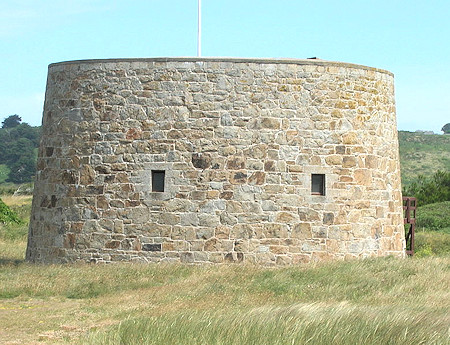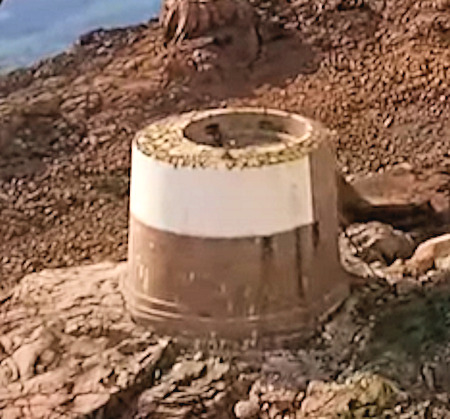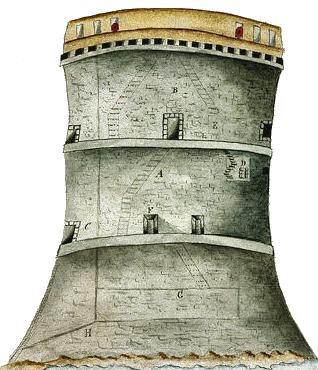Martello Towers In Jersey & Guernsey
Jersey
The British built eight true Martello towers in Jersey, three between 1808 and 1814, and five between 1834 and 1837, one of which, L'Etacq, the German occupation forces destroyed during World War II.
The three original towers are:
Icho Tower (1811)
Portelet Tower (1808)
La Tour de Vinde (AKA Noirmont; 1808–1814)
The four, later towers, are:
Lewis Tower (AKA St Ouen 1; 1835)
Kempt Tower (AKA St Ouen 2; 1834)
La Collette Tower – Absorbed into the 19th-century artificers' barracks and workshops
Victoria Tower (1837)
In addition, there are a number of towers in Jersey (the Jersey Round Towers), that are frequently referred to as Martello towers, though they are not Martellos. They were built in the late 18th century, ie, before the Martellos, and differ from them in a number of ways. One may think of them as precursors, like the Genoese towers they resemble.

Kempt Tower, in La Grande Cueillette, Saint Ouen, Jersey, is also known as Saint Ouen No. 2 and La Grôsse Tou in Jèrriais, and is a Martello tower that the British completed in 1834. It is named for Sir James Kempt, the Master-General of the Ordnance from 1830 to 1834.
While governor of Canada, Kempt was involved in the planning for the use of Martello towers to protect the colony. Currently, Kempt Tower serves as the interpretation centre for Les Mielles conservation area.
Kempt Tower has a cam-shaped base, and has a trefoil gun platform. It too has a thicker-walled side facing the sea. It is shorter and wider than its near neighbour, Lewis Tower. The interior of the tower is a doughnut-shaped space around a brick column, and has a curved ceiling.

Kempt Tower Jersey
The tower measures 35 ft (11 m) in height and 27 ft (8.2 m) in diameter. The door at ground level represents a modification by the German occupation of the Channel Islands.
The tower itself was armed with a 24-pounder gun and two 24-pounder short guns. In front of the tower there was a paved redoubt that was armed with three 24-pounder guns.
This Martello Tower has been restored with all modern conveniences and fully equipped as a self-catering property.
Icho Tower was built in 1811 on a small islet, almost 1.5 miles from the shore and can only be reached on the lowest tides.
Icho Tower with a base diameter of 42ft (13m) and a height of 39ft (12m) was as large as the English south-coast towers, although circular in shape. Unusually, it has a number of loopholes at ground-floor level facing the sea.
Located on the rocks of the Banc du Violet about 1.6km offshore from the south-east corner of the island, the tower was designed to support the Seymour Tower and its battery of two 12-pounder cannons a mile or so to the east.
Together the two defended the channel to Platte Rocque and the construction of the Icho Tower seems to have been a belated strengthening of the defences covering the approach used by the Baron de Rullecourt when he landed on Jersey in 1781. This granite ashlar tower was armed with one 24-pounder cannon on the gun platform.
The garrison of these towers would have been a sergeant and 12 men.

Icho Tower Jersey
This tower, also known as Pointe des Pas, was conceived as a communication link between Fort Regent and Elizabeth Castle, and also gave protection to the approach to the early elements of St Helier Harbour and the coastline eastwards from Havre des Pas. It was constructed about 1834 in the Martello style.
Portelet Tower is built on a small island, known as Ile de Guerdain, in Portelet Bay, Jersey.
The tower is popularly known as Janvrin's Tomb because sea captain Philippe Janvrin was buried thereafter he died of the plague, but this was some considerable time before the tower was built.
The tower consists of only one room and was more of a guardhouse than a Martello. It has a door at ground level and one window about seven feet above the ground level. It is built of rubble stone and measures 17 ft (5.2 m) in height and 27 ft (8.2 m) in diameter.
After its completion in March 1808, Lieutenant Governor George Don ordered that coal be brought that a fire might be burned in it day and night for two weeks to dry it out.
A garrison consisting of a sergeant and 12 men then occupied the fort, which was armed with an 18-pounder carronade.
It is styled on the Martello design and was completed by March 1808, when the Lieut-Governor, General Don requested that it be dried out for a fortnight and then occupied by a sergeant and twelve men.

Portelet Tower
There are three Martello towers in Guernsey, all built in 1804: Fort Grey, Fort Hommet and Fort Saumarez.
In addition, there are a number of earlier towers in Guernsey (the Guernsey loophole towers), that many people refer to as Martello towers, though they are not Martellos. They were built in the late 18th century, i.e., before the Martellos, and differ from them in a number of ways. One may think of them as precursors, like the Genoese towers they resemble.
Lastly, Bréhon Tower, built in 1856, is an oval tower that represents the final evolution of the Martello tower.









 Red Dragon I.T. Ltd.
Red Dragon I.T. Ltd.